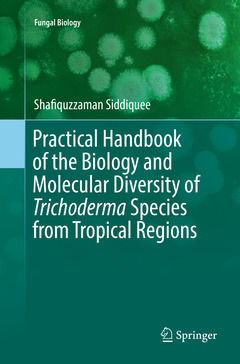Description
Practical Handbook of the Biology and Molecular Diversity of Trichoderma Species from Tropical Regions, 1st ed. 2017
Fungal Biology Series
Author: Siddiquee Shafiquzzaman
Language: English
Subjects for Practical Handbook of the Biology and Molecular...:
105.49 €
In Print (Delivery period: 15 days).
Add to cartPublication date: 08-2018
Support: Print on demand
105.49 €
In Print (Delivery period: 15 days).
Add to cartPublication date: 09-2017
Support: Print on demand
Description
/li>Contents
/li>Biography
/li>Comment
/li>
Chapter 1. The Basic Concept of Microbiology.- Chapter 2. Collection and Processing For Trichoderma Specimen.- Chapter 3. Slide Culturing of Trichoderma Isolates.- Chapter 4.- Morphological Based Characterization of Trichoderma Species.- Chapter 5. Molecular Characteristics of Trichoderma Strains.
Shafiquzzaman Siddiquee, PhD is an associate professor at the Biotechnology Research Institute of Universiti Malaysia Sabah (UMS), Malaysia. Dr. Siddiquee obtained his MSc (Molecular Microbiology) and PhD (Bioelectrochemistry) degrees in 2008 and 2010, respectively from University Putra Malaysia (UPM), Malaysia. In 2011, Dr. Siddiquee received a Best Post Graduate Award from UPM for being the most outstanding postgraduate student of the year. In 2014, he was the winner of the ProSPER.net-Scopus Young Scientist Award in the category of Sustainable Agriculture. He served as a guest professor at the Institute of Analytical Chemistry, Chemo- and Biosensors of the University of Regensburg, Germany. Currently he is a head of the UMS Biosensor Research Group. He is involved in varying types of research areas, including chemo- and bio- sensors based research, and Trichoderma biodiversity and its applications. He has published over 65 refereed journal articles, 4 bo
oks, 10 book chapters and 30 proceeding papers. His findings yielded, so far, 4 patents, 5 invited speakers and 40 research awards, including awards from the 2015 MOHE entrepreneurial Project Award and the International Conference and Exposition on Inventions by Institutions of Higher Learning 2015 (PECIPTA). Both nationally and internationally, Dr. Siddiquee has established relevant research group networks. In pop culture, Dr. Siddiquee findings' have been broadcast in Malaysian national television (TV1, TV2 and TV7) and highlighted in various printed media.



